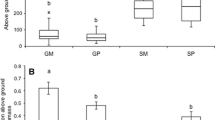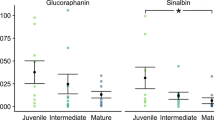Abstract
Herbivory can negatively affect several components of plant reproduction. Yet, because of a lack of experimental studies involving multiple populations, the extent to which differences in herbivory contribute to among-population variation in plant reproductive success is poorly known. We experimentally determined the effects of insect herbivory on reproductive output in nine natural populations of the perennial herb Lythrum salicaria along a disturbance gradient in an archipelago in northern Sweden, and we quantified among-population differentiation in resistance to herbivory in a common-garden experiment in the same area. The intensity of leaf herbivory varied >500-fold and mean female reproductive success >400-fold among the study populations. The intensity of herbivory was lowest in populations subject to strong disturbance from ice and wave action. Experimental removal of insect herbivores showed that the effect of herbivory on female reproductive success was correlated with the intensity of herbivory and that differences in insect herbivory could explain much of the among-population variation in the proportion of plants flowering and seed production. Population differentiation in resistance to herbivory was limited. The results demonstrate that the intensity of herbivory is a major determinant of flowering and seed output in L. salicaria, but that differences in herbivory are not associated with differences in plant resistance at the spatial scale examined. They further suggest that the physical disturbance regime may strongly influence the performance and abundance of perennial herbs and patterns of selection not only because of its effect on interspecific competition, but also because of effects on interactions with specialized herbivores.





Similar content being viewed by others
References
Ågren J (1988) Between-year variation in flowering and fruit set in frost-prone and frost-sheltered populations of dioecious Rubus chamaemorus. Oecologia 76:175–183. doi:10.1007/BF00379950
Ågren J (1996) Population size, pollinator limitation, and seed set in the self-incompatible herb Lythrum salicaria. Ecology 77:1779–1790. doi:10.2307/2265783
Ågren J, Ehrlén J, Solbreck C (2008) Spatio-temporal variation in fruit production and seed predation in a perennial herb influenced by habitat quality and population size. J Ecol 96:334–345. doi:10.1111/j.1365-2745.2007.01334.x
Ågren J, Hellström F, Toräng P, Ehrlén J (2013) Mutualists and antagonists drive among-population variation in selection and evolution of floral display in a perennial herb. Proc Natl Acad Sci USA 110:18202–18207. doi:10.1073/pnas.1301421110
Alonso C, Herrera CM (1996) Variation in herbivory within and among plants of Daphne laureola (Thymelaeaceae): correlation with plant size and architecture. J Ecol 84:495–502. doi:10.2307/2261472
Bale JS, Masters GJ, Hodkinson ID et al (2002) Herbivory in global climate change research: direct effects of rising temperature on insect herbivores. Global Change Biol 8:1–16. doi:10.1046/j.1365-2486.2002.00451.x
Bates DM, Chambers JM (1992) Nonlinear models. In: Chambers JM, Hastie TJ (eds) Statistical models. S. Wadsworth & Brooks/Cole, Pacific Grove
Benkman CW, Smith JW, Maier M et al (2013) Consistency and variation in phenotypic selection exerted by a community. Evolution 67:157–169. doi:10.1111/j.1558-5646.2012.01736.x
Boege K, Marquis RJ (2005) Facing herbivory as you grow up: the ontogeny of resistance in plants. Trends Ecol Evol 20:441–448. doi:10.1016/j.tree.2005.05.001
Bradley KL, Damschen EI, Young LM et al (2003) Spatial heterogeneity, not visitation bias, dominates variation in herbivory. Ecology 84:2214–2221. doi:10.1890/02-3082
Castillo G, Cruz LL, Hernández-Cumplido J et al (2013) Geographic association and temporal variation of chemical and physical defense and leaf damage in Datura stramonium. Ecol Res 28:663–672. doi:10.1007/s11284-013-1059-4
Crawley M (1989) Insect herbivores and plant population dynamics. Annu Rev Entomol 34:531–564. doi:10.1146/annurev.ento.34.1.531
De Frenne P, Kolb A, Verheyen K et al (2009) Unravelling the effects of temperature, latitude and local environment on the reproduction of forest herbs. Global Ecol Biogeogr 18:641–651. doi:10.1111/j.1466-8238.2009.00487.x
Didiano TJ, Turley NE, Everwand G et al (2014) Experimental test of plant defence evolution in four species using long-term rabbit exclosures. J Ecol 102:584–594. doi:10.1111/1365-2745.12227
Ehrlén J (1995) Demography of the perennial herb Lathyrus vernus. 2. Herbivory and population dynamics. J Ecol 83:297–308. doi:10.2307/2261568
Ehrlén J (2003) Fitness components versus total demographic effects: evaluating herbivore impacts on a perennial herb. Am Nat 162:796–810. doi:10.1086/379350
Elderd BD (2006) Disturbance-mediated trophic interactions and plant performance. Oecologia 147:261–271. doi:10.1007/s00442-005-0267-1
Ericson L, Wallentinus H-G (1979) Sea-shore vegetation around the Gulf of Bothnia. Guide for the International Society for Vegetation Science. July–August 1977. Wahlenbergia 5:1–142
Fornoni J (2011) Ecological and evolutionary implications of plant tolerance to herbivory. Funct Ecol 25:399–407. doi:10.1111/j.1365-2435.2010.01805.x
Fornoni J, Valverde PL, Núñez-Farfán J (2004) Population variation in the cost and benefit of tolerance and resistance against herbivory in Datura stramonium. Evolution 58:1696–1704. doi:10.1111/j.0014-3820.2004.tb00455.x
Fox J (2003) Effect displays in R for generalised linear models. J Stat Softw 8:1–27
Grevstad FS (2006) Ten-year impacts of the biological control agents Galerucella pusilla and G. calmariensis (Coleoptera: Chrysomelidae) on purple loosestrife (Lythrum salicaria) in Central New York State. Biol Control 39:1–8. doi:10.1016/j.biocontrol.2006.03.007
Grevstad FS, Herzig AL (1997) Quantifying the effects of distance and conspecifics on colonization: experiments and models using the loosestrife leaf beetle, Galerucella calmariensis. Oecologia 110:60–68. doi:10.1007/s004420050133
Grubb P (1977) Maintenance of species-richness in plant communities—importance of regeneration niche. Biol Rev 52:107–145. doi:10.1111/j.1469-185X.1977.tb01347.x
Gudleifsson BE, Hallas TE, Olafsson S, Sveinsson T (2002) Chemical control of Penthaleus major (Acari: Prostigmata) in hayfields in Iceland. J Econ Entomol 95:307–312. doi:10.1603/0022-0493-95.2.307
Hambäck PA (2010) Density-dependent processes in leaf beetles feeding on purple loosestrife: aggregative behaviour affecting individual growth rates. Bull Entomol Res 100:605–611. doi:10.1017/S000748530999068X
Hambäck PA, Ågren J, Ericson L (2000) Associational resistance: insect damage to purple loosestrife reduced in thickets of sweet gale. Ecology 81:1784–1794. doi:10.1890/0012-9658(2000)081[1784:ARIDTP]2.0.CO;2
Hodkinson ID (2005) Terrestrial insects along elevation gradients: species and community responses to altitude. Biol Rev 80:489–513. doi:10.1017/S1464793105006767
Horvitz C, Schemske D (1995) Spatiotemporal variation in demographic transitions of a tropical understory herb—projection matrix analysis. Ecol Monogr 65:155–192. doi:10.2307/2937136
Hothorn T, Bretz F, Westfall P (2008) Simultaneous inference in general parametric models. Biometrical J 50:346–363. doi:10.1002/bimj.200810425
Hultén E, Fries M (1986) Atlas of North European vascular plants North of the Tropic of Cancer, vol I–III. Koeltz, Königstein
Hunt-Joshi TR, Blossey B, Root RB (2004) Root and leaf herbivory on Lythrum salicaria: implications for plant performance and communities. Ecol Appl 14:1574–1589. doi:10.1890/03-5181
Johnson MTJ, Agrawal AA, Maron JL, Salminen J-P (2009) Heritability, covariation and natural selection on 24 traits of common evening primrose (Oenothera biennis) from a field experiment. J Evol Biol 22:1295–1307. doi:10.1111/j.1420-9101.2009.01747.x
Katovich EJS, Ragsdale DW, Skinner LC, Becker RL (2009) Effect of Galerucella spp. feeding on seed production in purple loosestrife. Weed Sci 49:190–194. doi:10.1614/0043-1745(2001)049[0190:EOGSFO]2.0.CO;2
Kuznetsova A, Brockhoff PB, Bojesen Christensen RH (2014) lmerTest: tests for random and fixed effects for linear mixed effect models (lmer objects of lme4 package). R package version 2.0-11. http://CRAN.R-project.org/package=lmerTest
Lehndal L, Ågren J (2015a) Herbivory differentially affects plant fitness in three populations of the perennial herb Lythrum salicaria along a latitudinal gradient. PLoS ONE 10(9):e0135939. doi:10.1371/journal.pone.0135939
Lehndal L, Ågren J (2015b) Latitudinal variation in resistance and tolerance to herbivory in the perennial herb Lythrum salicaria is related to intensity of herbivory and plant phenology. J Evol Biol 28:576–589. doi:10.1111/jeb.12589
Løe G, Toräng P, Gaudeul M, Ågren J (2007) Trichome production and spatiotemporal variation in herbivory in the perennial herb Arabidopsis lyrata. Oikos 116:134–142. doi:10.1111/j.2006.0030-1299.15022.x
Louda S (1982) Distribution ecology: variation in plant recruitment over a gradient in relation to insect seed predation. Ecol Monogr 52:25–41. doi:10.2307/2937343
Maron JL (1998) Insect herbivory above- and belowground: individual and joint effects on plant fitness. Ecology 79:1281–1293. doi:10.2307/176743
Maron JL, Crone E (2006) Herbivory: effects on plant abundance, distribution and population growth. Proc R Soc B Biol Sci 273:2575–2584. doi:10.1098/rspb.2006.3587
Menge B, Sutherland J (1987) Community regulation—variation in disturbance, competition, and predation in relation to environmental stress and recruitment. Am Nat 130:730–757. doi:10.1086/284741
Miller TE, Louda SM, Rose KA, Eckberg JO (2009) Impacts of insect herbivory on cactus population dynamics: experimental demography across an environmental gradient. Ecol Monogr 79:155–172. doi:10.1890/07-1550.1
Morris WF, Hufbauer RA, Agrawal AA et al (2007) Direct and interactive effects of enemies and mutualists on plant performance: a meta-analysis. Ecology 88:1021–1029. doi:10.1890/06-0442
Mueller RC, Wade BD, Gehring CA, Whitham TG (2005) Chronic herbivory negatively impacts cone and seed production, seed quality and seedling growth of susceptible pinyon pines. Oecologia 143:558–565. doi:10.1007/s00442-005-0029-0
Muola A, Mutikainen P, Laukkanen L et al (2010a) Genetic variation in herbivore resistance and tolerance: the role of plant life-history stage and type of damage. J Evol Biol 23:2185–2196. doi:10.1111/j.1420-9101.2010.02077.x
Muola A, Mutikainen P, Lilley M et al (2010b) Associations of plant fitness, leaf chemistry, and damage suggest selection mosaic in plant–herbivore interactions. Ecology 91:2650–2659. doi:10.1890/09-0589.1
Olsson K, Ågren J (2002) Latitudinal population differentiation in phenology, life history and flower morphology in the perennial herb Lythrum salicaria. J Evol Biol 15:983–996. doi:10.1046/j.1420-9101.2002.00457.x
Pennings SC, Ho C-K, Salgado CS et al (2009) Latitudinal variation in herbivore pressure in Atlantic Coast salt marshes. Ecology 90:183–195. doi:10.1890/08-0222.1
Puentes A, Ågren J (2012) Additive and non-additive effects of simulated leaf and inflorescence damage on survival, growth and reproduction of the perennial herb Arabidopsis lyrata. Oecologia 169:1033–1042. doi:10.1007/s00442-012-2276-1
R Development Core Team (2011) R: a language and environment for statistical computing. R Foundation for Statistical Computing, Vienna
Ramula S, Knight TM, Burns JH, Buckley YM (2008) General guidelines for invasive plant management based on comparative demography of invasive and native plant populations. J Appl Ecol 45:1124–1133. doi:10.1111/j.1365-2664.2008.01502.x
Rand TA (2002) Variation in insect herbivory across a salt marsh tidal gradient influences plant survival and distribution. Oecologia 132:549–558. doi:10.1007/s00442-002-0989-2
Root RB (1996) Herbivore pressure on goldenrods (Solidago altissima): its variation and cumulative effects. Ecology 77:1074–1087. doi:10.2307/2265577
Schemske D, Horvitz C (1988) Plant–animal interactions and fruit production in a neotropical herb: a path-analysis. Ecology 69:1128–1137. doi:10.2307/1941267
Silvertown J, Franco M, Pisanty I, Mendoza A (1993) Comparative plant demography—relative importance of life-cycle components to the finite rate of increase in woody and herbaceous perennials. J Ecol 81:465–476. doi:10.2307/2261525
Stenberg JA, Witzell J, Ericson L (2006) Tall herb herbivory resistance reflects historic exposure to leaf beetles in a boreal archipelago age-gradient. Oecologia 148:414–425. doi:10.1007/s00442-006-0390-7
Thompson JN (2005) The geographic mosaic of coevolution. University of Chicago Press, Chicago
Thompson JN (2013) Relentless evolution. University of Chicago Press, Chicago
Toräng P, Ehrlén J, Ågren J (2010) Habitat quality and among-population differentiation in reproductive effort and flowering phenology in the perennial herb Primula farinosa. Evol Ecol 24:715–729. doi:10.1007/s10682-009-9327-z
Valverde T, Silvertown J (1998) Variation in the demography of a woodland understorey herb (Primula vulgaris) along the forest regeneration cycle: projection matrix analysis. J Ecol 86:545–562. doi:10.1046/j.1365-2745.1998.00280.x
von Euler T, Ågren J, Ehrlén J (2014) Environmental context influences both the intensity of seed predation and plant demographic sensitivity to attack. Ecology 95:495–504. doi:10.1890/13-0528.1
Waites AR, Ågren J (2004) Pollinator visitation, stigmatic pollen loads, and among-population variation in seed set in Lythrum salicaria. J Ecol 92:512–526. doi:10.3732/ajb.93.1.142
Więski K, Pennings S (2014) Latitudinal variation in resistance and tolerance to herbivory of a salt marsh shrub. Ecography 37:763–769. doi:10.1111/ecog.00498
Willson MF, Price PW (1980) Resource limitation of fruit and seed production in some Asclepias species. Can J Bot 58:2229–2233. doi:10.1139/b80-257
Wise MJ, Abrahamson WG (2007) Effects of resource availability on tolerance of herbivory: a review and assessment of three opposing models. Am Nat 169:443–454. doi:10.1086/512044
Yeates AG, Schooler SS, Garono RJ, Buckley YM (2012) Biological control as an invasion process: disturbance and propagule pressure affect the invasion success of Lythrum salicaria biological control agents. Biol Invasions 14:255–271. doi:10.1007/s10530-011-0060-5
Acknowledgments
The study was funded by a grant from the Swedish Research Council to JÅ.
Author contribution statement
LE, PH, and JÅ conceived and designed the experiments. PH and JÅ performed the experiments. LL and JÅ analyzed the data. LL, PH, LE, and JÅ wrote the manuscript.
Author information
Authors and Affiliations
Corresponding author
Additional information
Communicated by Jennifer Thaler.
Rights and permissions
About this article
Cite this article
Lehndal, L., Hambäck, P.A., Ericson, L. et al. Herbivory strongly influences among-population variation in reproductive output of Lythrum salicaria in its native range. Oecologia 180, 1159–1171 (2016). https://doi.org/10.1007/s00442-015-3520-2
Received:
Accepted:
Published:
Issue Date:
DOI: https://doi.org/10.1007/s00442-015-3520-2




